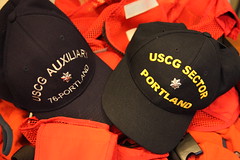This blog exists in a much larger context. The Coast Guard is exploring ways to use social media for communication within the service and to our partners and the public. The links from this post will help you understand the use of social media in the Coast Guard.
Note: This post will be updated as resources are added.
First, the Commandant's introduction to Social Media:
30 APR 2009: Wired's Danger Room: Coast Guard Commandant Hearts Social Media
Discusses the Commandant's use of social media.
26 APR 2009: Information Dissemination
Discusses the Navy and social media focusing on the fact that dealing with the blogging community and the mainstream media is not an either/or decision. In my professional life as a PR pro I find that an increasing number of my mainstream media audience is using the social web and that by effectively using a combination of traditional and social media tools I can reach them with less effort to greater effect. at the same time using social tools also makes me a publisher - I can go direct to my audience with the same set of messaging for no additional effort. It is truly a win-win-win.
20 APR 2009: Information Dissemination: Social Software and the National Security Discussion
An excellent post that introduced me to a paper by the National Defense University on social software and national defense. The paper puts forth an interaction model that is very useful when trying to understand social media and the potential impacts of the tools.
The report includes a good summary of how social software can work for the military services.
The first function is Inward Sharing, or sharing information within agencies. This includes information sharing not only during military operations, but also within offices for budgets, human resources, contracting, social, and other purposes, and coordination between offices and other units of an agency.
The second function is Outward Sharing, or sharing internal agency information with entities beyond agency boundaries. Outward sharing includes coordination during the Federal interagency process; sharing information with government, law enforcement, medical emergency, and other relevant entities at state, local, and tribal levels; and collaboration with partners such as corporations, non-governmental organizations (NGOs), or super-empowered individuals (billionaires, international CEOs, etc.).
The third function is Inbound Sharing, which allows government to obtain input from citizens and other persons outside the government more easily. Inbound Sharing includes gauging public sentiment on issues in real time (not unlike instant polling), allows government to receive input on current topics of interest, empowers the public to vote or otherwise give weight to other people’s opinions to reach some consensus or equilibrium about online discussions about government issues, and provides a mechanism for crowdsourcing, which is effectively outsourcing projects to a group of people whose membership is not predefined (not unlike a contest or challenge).
The fourth function is Outbound Sharing, whose purpose is to communicate with and/or empower people outside the government. This includes a range of efforts such as focused use of information and communications technology (ICT) during stabilization and reconstruction missions, connecting persons in emergency or post-disaster situations, and communicating messages in foreign countries as part of public diplomacy efforts. It also includes functions like using multimedia and social media for better communication with citizens as part of public affairs.







